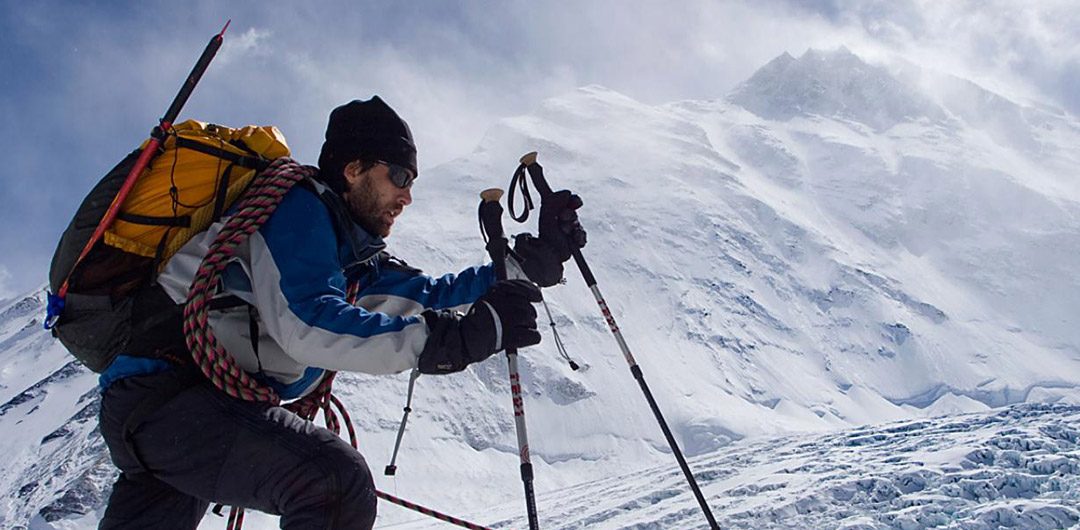August 6, 1996 – El Capitan – Yosemite National Park, California: For three days, Ed Weihenmayer had been following his 28-year-old son Erik’s climb up the 3,000-foot granite wall called El Capitan. Ed sat in a lawn chair with his telescope, craning his neck as Erik and his three buddies slowly climbed higher and higher. A few feet away from Ed, Erik’s wife, Ellie, could not bear to look as the climbers approached 2,500 feet.
When a crowd of tourists walked up, Ed pointed and proudly said, “That’s my son way up there.” A large woman in a floppy hat asked, “Aren’t you afraid?” Ed responded, “Sure, especially since he’s blind.” “Blind?” she repeated in astonishment. “And you let him do that? You are his Father!” She turned to her husband, “Let’s go honey, I think we’ve seen enough.” As she headed for the car, Ed couldn’t resist, “And he also skydives.”
Born in Princeton, New Jersey, Erik Weihenmayer was diagnosed with retinoschisis, a rare eye disease, at 15 months old. Ed and Ellen Weihenmayer were determined their son would do the things that other boys could do, despite his blindness. When Erik was 6, Ed took the training wheels off his bicycle and taught him to ride. When Erik crashed, which was often, Ed would always pick him up.
Erik excelled at wrestling in high school and made it to the National Junior Freestyle Championship in Iowa. At age 16, he discovered rock climbing at a summer camp and fell in love with the sport. He was a natural. Aided by his blindness, Erik was especially adept in feeling the little knobs, cracks and fissures in the rock. To him, it was like solving a puzzle in the rock.
Erik graduated from Boston College with a degree in English and moved to Phoenix to become a teacher and wrestling coach. In his early 20’s, he married Ellie and his love of rock climbing expanded to mountain climbing. Never one to back down from a challenge, Erik climbed increasingly difficult peaks.
In 1995, Erik’s friends thought he was a fool when a climbing buddy challenged him to climb 20,300-foot Denali in Alaska, the highest peak in North America. With the help of several other climbers, he did it. A year later, Erik was scaling El Capitan as his father nervously watched from below.
On May 25, 2001, supported by a $250,000 sponsorship from the National Blind Federation and a 19-member team, Erik became the first blind person to stand on top of the world when he reached the summit of Mt. Everest, the world’s tallest mountain at more than 29,000 feet. Time magazine honored Erik by featuring him on the cover.
Only 10% of the climbers who attempt Mt. Everest make it to the top. Under the best conditions it is physically, mentally and emotionally grueling for elite climbers. Climbing experts say the idea of a blind climber even attempting this dangerous feat is beyond ridiculous – it is absurd.
According to Time, “What Erik Weihenmayer achieved is hard for a sighted person to comprehend. There is no way to put what Erik has done into perspective because no one has ever done anything like it. It is a unique achievement. One that, in the truest sense, pushes the limits of what man is capable of.”
Erik has also completed the Seven Summits Challenge by climbing the highest mountain on each of the seven continents. He is the only blind climber and one of only 500 climbers who have climbed into this exclusive club. His Mt. Everest climb ranks as No. 4 of the list of the greatest ascents of the tallest mountain on earth.
Today, Erik continues to climb and manages No Barriers, a nonprofit organization he founded. The organization teaches outdoor skills to physically challenged people. He is also one of the world’s most sought-after motivational speakers.
“What’s in you is stronger than what’s in your way.” Erik Weihenmayer

Very inspirational story. Thanks
Great quote
Loved the quote…saved it for my nieces and nephews and children…